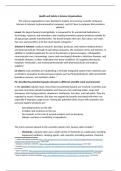Other
Laboratory Techniques and their Application - Unit 4 Coursework
- Institution
- PEARSON (PEARSON)
grade : distinction about a very detailed essay about different chromatography techniques for making organic substances that will provide you with the information and structures you need.
[Show more]



